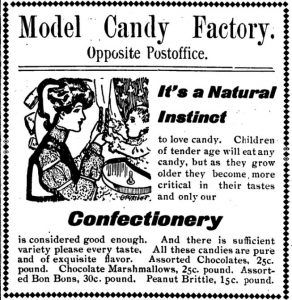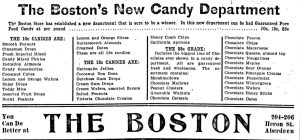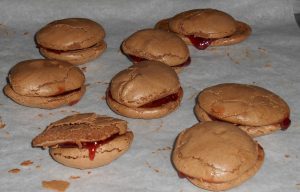Chocolate was all the rage in the United States at the turn of the century. In an era before mass produced commercial chocolate candy had taken over, how did people in Grays Harbor County enjoy one of the country’s favorite desserts?
 Chocolate’s Origins
Chocolate’s Origins
Chocolate has a long history. First cultivated in Mesoamerica by the Mayans and Aztecs, chocolate became very popular in Europe in the 18th century. Originally as a drink and later in candy and baking, Europeans brought their love for the cocoa bean to what became the United States. By the turn of the 20th century, more people could afford chocolate than ever before as the Industrial Revolution made large-scale chocolate production possible.
Buying Chocolate in Grays Harbor
The chocolate available at Grays Harbor County stores at the turn of the century came in two types: handmade candy and powdered/bars for cooking and baking. Baking chocolate was available at local grocers. Local and regional candy makers controlled the candy market, selling candy at drug stores, grocers and specialty shops. Local specialty stores included both the Model Bakery and Candy Factory and the Aberdeen Candy Works. The Boston store probably offered the widest variety of chocolates in the area. For a 25 cents a pound, a person could purchase chocolate-flavored marshmallows, caramels, pecans, chips, macaroons, almond queens, nougats, maples, sour oranges, pineapple creams, peppermints, wafers, honey sticks, dates and, for 15 cents a pound, chocolate Victoria creams.

For those dining out, a cup of hot chocolate or a slice of chocolate cake was available at local restaurants. The Grayport Tea and Coffee Company in Aberdeen served hot chocolate at their cafeteria alongside their hot waffles, steamed rice and chicken tamales.
Even businesses not involved in the food trade knew chocolate-related items brought customers in. To cap off a week of door prizes, the Edison Theater in Aberdeen gave away a silver hot chocolate pot in October 1903.
No Event Complete Without Chocolate
With chocolate’s enduring popularity, it was a special part of the menu at local events. Typical was a social held by the Junior League Society of the Methodist Church of Aberdeen in April 1906. Guests sipped hot chocolate and ate cake while enjoying games, songs and recitations. Chocolate also helped attract customers to fundraisers. The Ladies Aid Society of the Methodist Church sold chocolate at their fair in 1906. And a hot chocolate serving set made a great gift. To celebrate the 15th wedding anniversary in 1897 of Methodist Reverend Oscar S. Smith and his wife, his former parishioners in Centralia sent the couple a silver hot chocolate service.
Chocolate and the Press
Local newspapers offer insight into contemporary turn of the century opinions about chocolate. In an era before calorie-counting, it was seen as an important part in a healthy diet. “Don’t go to bed hungry,” a “Little Hints” column advised in the Aberdeen Herald on December 24, 1903, “a glass of milk or a cup of chocolate will refresh you.”

“Chocolate is nourishing in the spring,” Anna Thompson wrote in her “Kitchen Cupboard” column in the same newspaper on July 11, 1912 “when we need something special to repair the system.” She suggested sneaking it into puddings for those who did not – gasp – like chocolate.
Chocolate consumption was especially promoted for children. The “Points for Mothers” column in the February 24, 1914 issue of the Aberdeen Herald praised milk chocolate as “probably the most wholesome sweet for children” because “It possesses real nutritive value,” and recommended it be served with mush as dessert. Many took this advice to heart. When the PTA of the Franklin School began sponsoring daily lunches for students in January 1914, they sold hot cocoa for two cents every other day.
But chocolate was not without its critics. “A box of chocolates and a matinee ticket constitute happiness for a great many girls of today,” admonished the Aberdeen Herald on October 3, 1912, “If the play is good the matinee ticket is a real benefit, which is more than can be said of the chocolate.” Nibbled between meals, chocolate could result in “aching teeth” and “disgruntled digestion.”
Cooking with Chocolate
Local newspapers were full of ideas of things to make with chocolate. Columns such as “The Household,” “Cookery Points” and “The Kitchen Cupboard” offered many recipes, especially baked goods and candy. Plain or spiced chocolate cake was particularly popular, as well as chocolate cake frosting and fillings. People could try their hand at making their own fudge, chocolate creams, peppermints, caramels and marshmallows. They could stuff dates with chocolate, bake or steam chocolate puddings and custards, and make chocolate cream pie. Chocolate ice cream mixed with nuts and candied fruit could be made into frozen plum pudding. A bit outside modern tastes were breath mints made with charcoal, saccharin, powdered vanilla and chocolate held together by gum arabic.

Absent, however, were such modern favorites as brownies and chocolate chip cookies. Cake-like brownies had been invented in the 1890s but had yet to become popular. Chocolate chip cookies were not invented until the 1930s. But chocolate cookies need not be plain. “Some cooks,” advised a list of “Culinary Conceits” in the Aberdeen Herald on November 5, 1908, “when preparing chocolate cookies like to add a few chopped raisins and nut meats minced.”
And after all that baking and boiling, cooks were faced with the question of what to do with discarded packaging. Inventive children could make cocoa tins into tin can telephones if they followed instructions from the Aberdeen Herald in May 1899.
Chocolate is now much more widely available and affordable in Grays Harbor County and its popularity remains unabated among people of all ages.











































